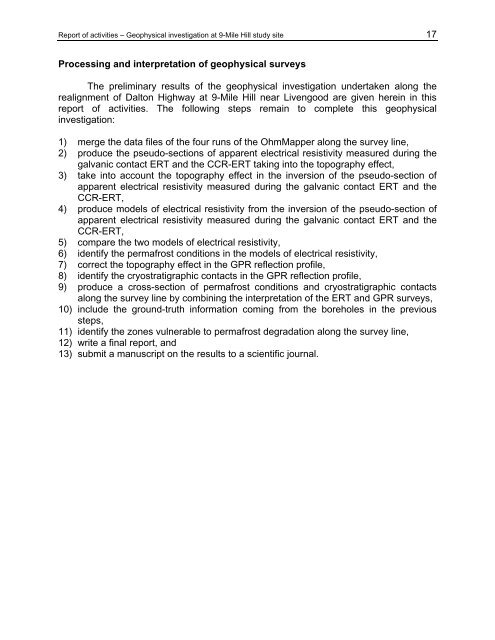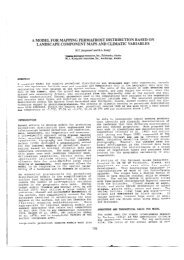Alaska University Transportation Center PROJECT - Institute of ...
Alaska University Transportation Center PROJECT - Institute of ...
Alaska University Transportation Center PROJECT - Institute of ...
Create successful ePaper yourself
Turn your PDF publications into a flip-book with our unique Google optimized e-Paper software.
Report <strong>of</strong> activities – Geophysical investigation at 9-Mile Hill study site 17<br />
Processing and interpretation <strong>of</strong> geophysical surveys<br />
The preliminary results <strong>of</strong> the geophysical investigation undertaken along the<br />
realignment <strong>of</strong> Dalton Highway at 9-Mile Hill near Livengood are given herein in this<br />
report <strong>of</strong> activities. The following steps remain to complete this geophysical<br />
investigation:<br />
1) merge the data files <strong>of</strong> the four runs <strong>of</strong> the OhmMapper along the survey line,<br />
2) produce the pseudo-sections <strong>of</strong> apparent electrical resistivity measured during the<br />
galvanic contact ERT and the CCR-ERT taking into the topography effect,<br />
3) take into account the topography effect in the inversion <strong>of</strong> the pseudo-section <strong>of</strong><br />
apparent electrical resistivity measured during the galvanic contact ERT and the<br />
CCR-ERT,<br />
4) produce models <strong>of</strong> electrical resistivity from the inversion <strong>of</strong> the pseudo-section <strong>of</strong><br />
apparent electrical resistivity measured during the galvanic contact ERT and the<br />
CCR-ERT,<br />
5) compare the two models <strong>of</strong> electrical resistivity,<br />
6) identify the permafrost conditions in the models <strong>of</strong> electrical resistivity,<br />
7) correct the topography effect in the GPR reflection pr<strong>of</strong>ile,<br />
8) identify the cryostratigraphic contacts in the GPR reflection pr<strong>of</strong>ile,<br />
9) produce a cross-section <strong>of</strong> permafrost conditions and cryostratigraphic contacts<br />
along the survey line by combining the interpretation <strong>of</strong> the ERT and GPR surveys,<br />
10) include the ground-truth information coming from the boreholes in the previous<br />
steps,<br />
11) identify the zones vulnerable to permafrost degradation along the survey line,<br />
12) write a final report, and<br />
13) submit a manuscript on the results to a scientific journal.




